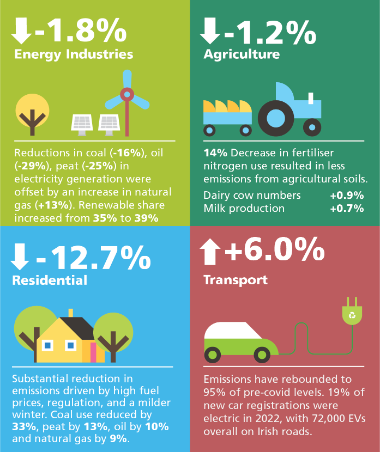Greenhouse gas (GHG) emissions in Ireland decreased 1.9% in 2022. The decrease in emissions are reflected in most of the large sectors with the exception of an increase in transport, waste and commercial services sectors.
Agriculture emission decreased by 1.2% in 2022 (0.29 Mt CO2eq). The main reasons are decreases of synthetic nitrogen fertiliser use of 14%. This was somewhat offset by the numbers of livestock increasing, including dairy cows by 0.9%, other cattle 0.3% and sheep 4.2% in 2022. Total milk production increased by 0.7% in 2022 with milk output per cow also decreasing slightly by 0.2%.

Energy industry emissions decreased by 1.8% (0.19 Mt CO2eq) in 2022 due to reductions in coal (-16.1%), oil (-29.1%) and peat (-24.8%) use in electricity generation.
In 2022 emissions in electricity generation:
Household emissions (the residential sector) decreased by 12.7% (0.89 Mt CO₂eq) in 2022. The reduction was caused by a combination of a milder winter and increased fuel prices. Coal, peat, natural gas and kerosene sales declined by 33.1%, 12.7%, 9.3% and 16.5% respectively. This demonstrates the effect weather has on heating requirements and hence emissions from households. This shows the need to improve the energy efficiency of our housing stock and to increase the use of renewable energy. It is particularly important, given the increased frequency of extreme weather events.
Transport emissions increased by 6.0% in 2022 (0.66 Mt CO2eq). This increase was largely caused by the ending of remaining COVID travel restrictions. Electric Vehicles now account for almost 37% of the 2025 policy target.
In road transport in 2022:
The impact of Electric Vehicles in reducing Transport emissions is still very low due to the low number in the vehicle fleet but they are projected to contribute substantially to emissions reductions towards the latter half of the 2020s. However, many more measures will need to be implemented to counter the projected increase in the overall fleet.
Ireland's emissions profile has changed considerably since 1990, with the contribution from transport more than doubling and the share from agriculture reducing since 1998. However, since 2011, emissions have trended upwards again with an overall peak in emissions reported in 2016. Agriculture is the largest source of emissions, representing 38.4 per cent of total national emissions in 2022, based on provisional estimates. Both the transport and energy industries sectors represent 19.1 and 16.6 per cent respectively, of total greenhouse gas emissions in 2022. The transport sector has been the fastest growing source of greenhouse gas emissions. Further information about Ireland's greenhouse gas emissions is available on our website.
View the indicator in full screen mode by clicking on the lined button beside it.

(Latest update June 2023)
Ireland's latest projections show total emissions (without LULUCF) decreasing from 2021 levels by 15% by 2030 under the With Existing Measures (WEM) scenario and by 32% under the With Additional Measures (WAM) scenario. The gap between both scenarios is largely attributed to significant reductions in key sectors such as power generation, residential, transport, commercial and public services and agriculture as a result of the Climate Action Plan 2023 and other policy documents such as Ag Climatise. Three key sectors; agriculture, transport and energy industries consistently have the largest share of emissions. Under the WEM scenario, emissions from agriculture and transport are projected to decrease by 4% and 1% respectively over the period 2021 to 2030. Emissions from energy industries are projected to decrease by 50% over the same period. When we look at the more ambitious WAM scenario, emissions from agriculture, energy and transport reduce by 20%, 60% and 35% respectively.
Full and early implementation of the Climate Action Plan 2023 is needed if the savings projected in the With Additional Measures are to materialise. The scale and pace of the changes needed are significant, requiring much greater reliance on renewables, cross-cutting measures such as an €100 per tonne of CO2 carbon tax by 2030 and further ambitious measures in sectors such as transport, agriculture and power generation.
Further information is available at the EPA's latest report Ireland' Greenhouse Gas Emissions Projections